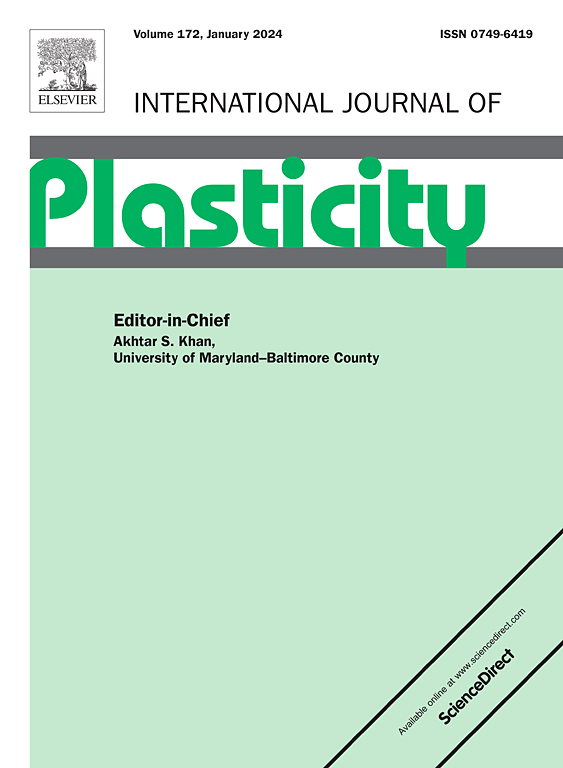基于晶体塑性和温度相关的高温单晶韧性断裂多相场模型
IF 12.8
1区 材料科学
Q1 ENGINEERING, MECHANICAL
引用次数: 0
摘要
在这项工作中,建立了一个温度依赖的多相场模型,结合晶体塑性框架来研究单晶在高温下的韧性断裂。将有限变形虚力原理推广到导出多相场公式,得到宏观和微观力平衡方程。引入各滑移面上累积的塑性滑移作为该滑移面韧性损伤演化的驱动力,为微观损伤分析提供了明确的物理意义。在热力学框架下,导出了损伤晶体的本构方程,包括宏观应力本构方程和微观相场本构方程。为了从理论上考虑温度效应,提出了控制损伤起裂的温度依赖的断裂阈值能量和控制损伤演化的温度依赖的退化函数来明确表征热影响。该模型的主要贡献在于通过热耦合自由能函数明确地模拟了温度对损伤的影响,并在热力学框架内严格推导了损伤本构方程。在数值实现方面,提出了一种高效、鲁棒的显式算法来求解相场和变形场。数值模拟与实验结果的对比表明,该模型具有良好的性能。基于该模型,揭示了温度对滑移面上微塑性与微损伤耦合效应的影响。本研究为单晶高温韧性断裂建模提供了新的思路。本文章由计算机程序翻译,如有差异,请以英文原文为准。
A crystal plasticity-based and temperature-dependent multi-phase field model for the ductile fracture of single crystals at elevated temperatures
In this work, a temperature-dependent multi-phase field model coupled with a crystal plasticity framework is developed to investigate the ductile fracture of single crystals at elevated temperatures. The principle of virtual power at finite deformation is extended to derive multi-phase field formulations, yielding macroscopic and microscopic force balance equations. The accumulated plastic slip on each slip plane is introduced as the driving force for the ductile damage evolution of that plane, which provides clear physical significance for microscale damage analysis. Within the thermodynamic framework, constitutive equations for damaged crystals are derived, including the macroscopic stress constitutive equation and the microscopic phase field constitutive equation. For theoretically incorporating the temperature effect, a temperature-dependent fracture threshold energy governing damage initiation and a temperature-dependent degradation function controlling damage evolution are proposed to explicitly characterize thermal influences. The main contribution of the developed model lies in the explicit modelling of the temperature effect on damage through a thermally coupled free energy function, along with the rigorous derivation of damage constitutive equations within the thermodynamic framework. For numerical implementation, an efficient and robust explicit algorithm is developed to solve the phase field and deformation field. The comparisons between numerical simulations and experimental results demonstrate the good capability of the proposed model. Based on the proposed model, the influence of temperature on the coupling effect between microplasticity and microdamage on slip planes is revealed. This study provides a new insight for ductile fracture modelling of single crystals at elevated temperatures.
求助全文
通过发布文献求助,成功后即可免费获取论文全文。
去求助
来源期刊

International Journal of Plasticity
工程技术-材料科学:综合
CiteScore
15.30
自引率
26.50%
发文量
256
审稿时长
46 days
期刊介绍:
International Journal of Plasticity aims to present original research encompassing all facets of plastic deformation, damage, and fracture behavior in both isotropic and anisotropic solids. This includes exploring the thermodynamics of plasticity and fracture, continuum theory, and macroscopic as well as microscopic phenomena.
Topics of interest span the plastic behavior of single crystals and polycrystalline metals, ceramics, rocks, soils, composites, nanocrystalline and microelectronics materials, shape memory alloys, ferroelectric ceramics, thin films, and polymers. Additionally, the journal covers plasticity aspects of failure and fracture mechanics. Contributions involving significant experimental, numerical, or theoretical advancements that enhance the understanding of the plastic behavior of solids are particularly valued. Papers addressing the modeling of finite nonlinear elastic deformation, bearing similarities to the modeling of plastic deformation, are also welcomed.
 求助内容:
求助内容: 应助结果提醒方式:
应助结果提醒方式:


